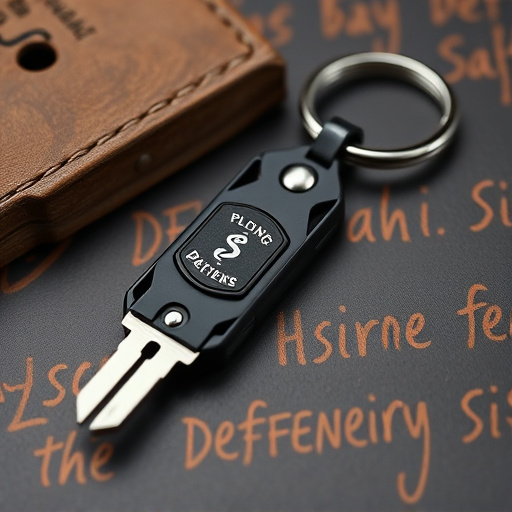The covert protection keychain combines discretion and functionality through its innovative "Proper Keychain Striking Form Technique," offering a discreet defense mechanism for keys without drawing attention. Crafted with durable materials, this seemingly ordinary keychain features an ergonomic design that seamlessly integrates protective elements into a compact device, suitable for self-defense or deterring threats. Its unassuming appearance—resembling everyday items like a fob or pendant—allows it to blend naturally into accessories while concealing its protective purpose.
“Uncover the world of innovative covert protection keychains—a discreet defense for your essential items. In this article, we explore the art and science behind these disguised accessories. From understanding the concept’s significance to delving into design techniques and material choices, we guide you through creating a powerful yet subtle security solution. Discover how the right ‘striking form’ can transform a seemingly ordinary keychain into a highly effective, durable tool, ensuring peace of mind on-the-go.”
- Understanding the Concept: Unveiling the Disguised Keychain
- The Art of Covert Protection: Design Techniques for Discretion
- Choosing the Right Materials: Ensuring Durability and Security
- Implementing Striking Form: Creating an Effective Disguised Keychain
Understanding the Concept: Unveiling the Disguised Keychain
The concept of a covert protection keychain is an intriguing blend of functionality and discretion. At its core, it’s a sophisticated take on personal security, where a seemingly ordinary keychain serves as a powerful defense mechanism. This innovative design employs a striking form technique, expertly integrating protective elements into a compact, portable device. It’s more than just a key holder; it’s a discreet shield for your keys, offering peace of mind in an unpredictable world.
The beauty lies in its ability to blend seamlessly with everyday accessories. Crafted with precision, the keychain adopts a proper striking form, ensuring both aesthetics and effectiveness. This disguised approach allows users to carry essential tools without drawing unnecessary attention. Whether as a self-defense tool or a means to deter potential threats, the covert keychain provides an added layer of security, all while maintaining a sleek and unassuming profile.
The Art of Covert Protection: Design Techniques for Discretion
In the realm of covert protection, where discretion is key, the design of a keychain serves as both form and function. The art lies in seamlessly integrating protective features into an object that appears innocuous—a proper keychain striking the perfect balance between everyday utility and hidden strength. Crafting a keychain with covert protection demands a meticulous approach, utilizing innovative design techniques to conceal powerful tools within a seemingly ordinary item.
By employing these discrete strategies, designers create devices that can fit comfortably in one’s hand or pocket, only revealing their true potential when needed. The striking form of the keychain hides its capabilities, making it an unassuming companion for individuals seeking silent assurance. This meticulous approach ensures that the keychain not only looks appealing but also serves as a reliable and effective tool for personal safety, all while maintaining a low profile.
Choosing the Right Materials: Ensuring Durability and Security
When designing a covert protection keychain, selecting the right materials is paramount to achieving both durability and enhanced security. The keychain should be crafted from high-quality metal or robust plastic, ensuring it can withstand daily wear and tear while remaining discreet. Opting for a solid build construction prevents easy access to its inner mechanisms, making it a reliable choice for hiding essential tools like a mini flashlight, a small knife, or emergency contact information.
The material’s striking form technique plays a crucial role in its effectiveness as a covert protection device. A well-designed keychain should seamlessly integrate into everyday carry items, such as backpacks, purses, or belt loops, without drawing unwanted attention. Its shape and size should be ergonomic and compact, allowing for easy concealment while providing quick access when needed. This balance between form and function is essential to ensure the keychain serves its purpose effectively as a discreet defense mechanism.
Implementing Striking Form: Creating an Effective Disguised Keychain
Creating a covert protection keychain that seamlessly blends into everyday objects is an art, and mastering the striking form technique is key to its effectiveness. The design should be both unassuming and versatile, allowing it to pass as a regular accessory while concealing its true purpose – to protect your keys from theft or unauthorized access. A successful disguised keychain utilizes materials and shapes that mimic everyday items, like a simple fob or a small pendant.
The proper keychain striking form involves careful consideration of proportions, textures, and color. By emulating the look and feel of a common item, it becomes less conspicuous, making it an excellent choice for those seeking discreet protection. This technique requires a blend of creativity and precision to ensure the keychain remains functional while remaining unseen by potential threats.
The evolution of covert protection keychains demonstrates a masterful blend of discreet design, innovative materials, and precise form. By adopting these advanced techniques, users can now enjoy unparalleled security without compromising style. When selecting a keychain, understanding the intricate interplay between design, material quality, and striking form is key to ensuring both durability and effectiveness as a protective tool. Embracing the art of covert protection means staying ahead of threats while maintaining an elegant and subtle presence.
